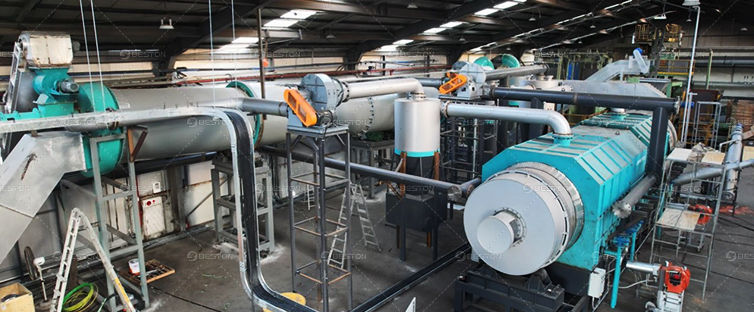Maximizing Efficiency in Biomass Pyrolysis Operations
- arbourz
- Oct 20
- 3 min read
The efficiency of biomass pyrolysis is a critical determinant of the economic viability and environmental performance of a pyrolysis plant. Optimizing the thermal conversion of organic feedstock into biochar, bio-oil, and syngas requires a thorough understanding of feedstock characteristics, reactor design, process parameters, and energy management. In high-capacity operations, even marginal improvements in efficiency can translate into significant gains in yield and profitability.
Feedstock Selection and Preparation
The initial stage of efficiency optimization begins with feedstock selection. Biomass with high lignocellulosic content, such as hardwood chips or agricultural residues, tends to produce higher yields of biochar and liquid oil. Moisture content is equally critical; feedstock with water content above 15–20% significantly increases energy consumption for drying, reducing overall thermal efficiency.
Pre-treatment strategies such as drying, size reduction, and sieving are essential. Uniform particle size ensures consistent heat transfer and reduces the formation of cold spots within the reactor. In continuous biomass pyrolysis plant, automated feed systems maintain steady throughput and minimize interruptions caused by uneven or oversized feedstock.

Reactor Design and Thermal Management
The design of the pyrolysis reactor directly impacts process efficiency. Continuous reactors, with controlled residence time and uniform heat distribution, outperform batch systems in both throughput and product consistency.
Temperature Control: Precise regulation of reaction temperature is crucial. Low temperatures may lead to incomplete decomposition, while excessively high temperatures increase gasification at the expense of bio-oil and char yield. Implementing advanced PID control systems and real-time thermal monitoring enables the reactor to maintain optimal pyrolysis conditions.
Heat Recovery: Integrating heat exchangers or circulating flue gases within the reactor design reduces the need for external fuel inputs. Non-condensable gases produced during pyrolysis can be redirected to sustain reactor temperatures, creating a self-sufficient energy loop. This not only lowers operational costs but also reduces the carbonization machine carbon footprint.
Process Parameter Optimization
Optimizing reaction parameters such as heating rate, residence time, and pressure is fundamental to maximizing efficiency.
Heating Rate: Moderate heating rates allow controlled thermal decomposition, minimizing char overproduction while maximizing liquid yields. Fast pyrolysis typically favors bio-oil production, whereas slow pyrolysis enhances biochar content. Selecting the appropriate heating profile based on desired outputs is critical.
Residence Time: Uniform residence time ensures that each biomass particle experiences adequate thermal exposure. In continuous pyrolysis plants, screw feeders or fluidized beds can maintain consistent residence times, improving product uniformity and conversion rates.
Pressure Control: Operating under slightly elevated pressure can improve vapor transport and condensation efficiency, enhancing the recovery of bio-oil while reducing tar formation.
Energy Integration and Circular Utilization
Energy management is a cornerstone of efficiency in biomass pyrolysis. Modern pyrolysis plants are increasingly designed to recycle energy streams internally.
Gas Recirculation: Non-condensable gases such as methane, hydrogen, and light hydrocarbons can be collected and redirected to fuel the reactor. This internal recycling reduces reliance on external energy sources and ensures continuous operation with minimal thermal losses.
Syngas Applications: Captured syngas may be used not only for internal heating but also as a feedstock for combined heat and power systems, increasing the overall energy conversion efficiency of the plant.
Process Integration: Linking bio-oil condensation, char collection, and gas handling within a unified control system enhances energy utilization, minimizes heat loss, and improves operational stability.
Automation and Monitoring
Advanced control systems are essential for operational efficiency. Continuous monitoring of temperature, pressure, and feedstock flow allows for real-time adjustments, preventing overprocessing or energy wastage. Automated alarm systems and predictive maintenance tools reduce unplanned downtime, maintaining consistent production quality.
Scalability and Modular Optimization
Large-scale operations benefit from modular pyrolysis plant design. Modular units allow for incremental capacity expansion while maintaining optimal thermal efficiency. Each module can operate under ideal conditions, reducing inefficiencies associated with scale-up in single large reactors.
Economic and Environmental Impact
Efficiency improvements not only enhance the economic return of biomass pyrolysis but also mitigate environmental impact. Higher conversion rates reduce feedstock consumption, lower energy input, and maximize the recovery of valuable products. Optimized pyrolysis operations contribute to sustainable carbon management and energy recovery, reinforcing the role of biomass pyrolysis in circular bioeconomy strategies.









Comments